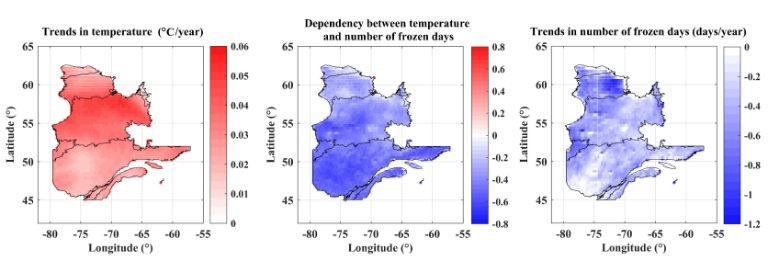Concordia researcher tracks the impact of climate change on freeze and thaw patterns in Quebec

With Canada experiencing warming at two times the global rate, winters in Montreal aren’t what they used to be. And the fluctuating temperatures have implications far beyond a slushy walk to work or the conditions at local skating rinks.
Shadi Hatami is a PhD candidate in water resources management in the Department of Building, Civil and Environmental Engineering in Concordia’s Gina Cody School of Engineering and Computer Science. She says climate change is having significant impacts on soil freeze and thaw patterns in Quebec and beyond. By studying various datasets across the past four decades, she shows how sectors ranging from farming to mining to roads and railways are all taking a hit.
Freeze and thaw patterns also control important environmental processes such as greenhouse gas emissions

How does this specific image relate to your research at Concordia?
Shadi Hatami: My research aims at identifying the impacts of climate change on soil freeze and thaw patterns across the Canadian landmass. This image, which is informed by NASA’s satellite imagery and climate data, shows how warming temperatures over Quebec have reduced the number of days in a typical year with frozen soil status.
The left panel shows the rate of change in annual temperature, highlighting that Quebec on average has warmed by 1.2 degrees Celsius over the period of 1979 to 2016. The middle panel displays the statistical dependence between annual temperature and number of frozen days in a year, showing that warmer air temperature can translate to lower number of days in which the soil is frozen.
Considering the high level of dependency between these two variables, the right panel shows that during this period the number of frozen days per year in Quebec has decreased on average by about 12 days. This has tremendous impacts on environmental processes and human activities.
What is the hoped-for result of your project?
SH: The main focus of my study is to find out how long-term disruptions to climate variables can alter soil freeze and thaw patterns throughout Canada. For this purpose, we have to characterize the statistical dependency between freeze and thaw patterns and relevant climate variables such as temperature and precipitation and address how this dependency can change across different landscapes and time episodes.
Our search has started by asking these questions in Quebec; however, we plan to extend our study to other regions of Canada.
What impact could you see it having on people’s lives?
SH: Freeze and thaw patterns are among the most important geological features of cold regions such as Canada. Traditionally, freeze and thaw patterns have dictated the way our socioeconomic activities developed across the country, from agriculture to mining to design and operation of important infrastructures such as roads and railways.
For instance, frozen soil conditions contribute to stability of mine tailings, while thawed soil conditions are necessary for agriculture. However, multiple swings between freeze and thaw conditions can damage crops, cause tension in concrete structures and reduce the life expectancy of buildings, bridges and roads. These can cost billions of dollars to taxpayers.
On a more long-term basis, freeze and thaw patterns also control important environmental processes such as greenhouse gas emissions in cold regions. Extended thawed periods mean the soil releases thousands of tons of methane and carbon emissions into the atmosphere, which increases the effect of ongoing global climate change.
What are some of the major challenges you face in your research?
SH: Finding reliable, good-quality datasets that can support our study is the first challenge. We use the satellite-based freeze and thaw data as well as climate re-analysis data that is available globally. However, this might not be reliable in some regions, particularly in northern latitudes. In addition, pairing datasets that are coming from different sources is indeed a challenge.
Another concern is developing a mathematical framework to represent the dependencies between climate and freeze/thaw characteristics. In many cases, such mathematical methodologies are not readily available. This requires some fundamental methodological developments that can be challenging.
What first inspired you to study this subject?
SH: As a civil engineer with a background in environmental and water resources, I am passionate about contributing to a better understanding of environmental issues, including impacts of climate change on human life and ecosystems.
There has been a lot of work on how climate change can alter hydroclimate variables such as temperature, precipitation and streamflow, but soil freeze and thaw have remained so far relatively untouched. As I mentioned, soil freeze and thaw have many practical implications for civil infrastructure, particularly in a cold country like Canada, and I would like to contribute to a better Canadian future.
What advice would you give interested students to get involved in this line of research?
SH: There are various research opportunities in climate change and hydrology. Perhaps the best place to begin is to learn about different research areas by attending public lectures and getting more exposure to relevant media outlets and public science journals. They should also invest in improving their background in mathematics and computer programming.
Another good step would be getting in touch with research groups that are actively working in these areas and participating in their meetings. In our lab, for instance, each year we have many invited speakers. Attending such events can be extremely helpful for getting familiar with hot topics as well as getting to know people who are active in the field.
What do you like best about being at Concordia?
SH: As a PhD student, Concordia has helped me tremendously to grow both personally and professionally. I am thankful to my supervisor, Ali Nazemi, my colleagues and other faculty members who have provided me with guidance and mentorship along the way.
So far, I have had many opportunities to attend several workshops and conferences and to meet other scientists working on similar topics. Such exposure has been important — it helped me earn the best student paper award at the 2019 Canadian Society for Civil Engineering conference in Laval, Que. As a fun fact, I was also lucky enough to meet my significant other at Concordia, in the same lab.
Are there any partners, agencies or other funding/support attached to your research?
SH: I would like to thank my supervisor for his support during the past years of my study through the Fonds de recherche du Québec - Nature et technologies. I should also extend my gratitude to Concordia for its generous International Tuition Award of Excellence and a number of conference and exposition awards. I also received bursaries from the Gina Cody School of Engineering and Computer Science.
Find out more about Concordia’s Department of Building, Civil and Environmental Engineering.


